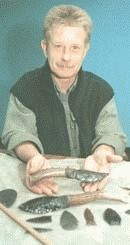ADDICTED TO FLINT KNAPPING
Published 12:00 am Friday, January 11, 2002

- Rex Watson displays two bi-face knives that he made from Oregon and California obsidian. The handles are from mule deer and elk antlers. (The Observer/PHIL BULLOCK).
STORY BY DICK MASON OF THE OBSERVER
La Grandes Rex Watson has lost plenty of blood over the past 25 years but not his sense of humor or popularity.
Watson is one of the most skilled makers of stone tools in Eastern Oregon and a sought-after teacher of his craft.
Students observing Watson at work constantly see slivers of sharp rock flying up. Watson, who always wears goggles while knapping, has been cut countless times.
I tell my students that all they need are two rocks and a box of bandages, Watson said. … It is a blood sport. You are always bleeding.
Watsons arrowheads are modeled after ones made by Native Americans in North America over the past 16,000 years. Watson often makes arrowheads and knives with the same tools Native Americans used. His knapping tools include stones and ivory from mule deer and moose antlers.
Watson often wonders what Native Americans went through while making arrowheads and knives.
I think about how many damaged themselves. They must have been cut all over and had a lot of eye injuries because they didnt have safety goggles, Watson said.
Native Americans stopped making arrowheads out of stone about 200 years ago when iron became available. Native Americans then began making tools with metal from wagon wheels and other sources.
Watson first learned about knapping from an archeologist at the University of Wyoming. He has been making stone tools ever since. He rarely misses a day of arrowhead making. This keeps his skill as sharp as the arrowheads and knives he makes. Watson fears his skill would erode if not for constant practice.
It is something that you have to do all the time. Its not like riding a bike, he said.
Practice, though, does make perfect.
You can never get good enough to satisfy yourself, Watson said, adding that none of the hundreds of knappers he knows are satisfied with their ability.
Watson enjoys knapping even though perfection is fleeting.
It is a form of meditation, Watson said. You have to concentrate so hard.
Watson and Bradley Phillips of La Grande have taught a knapping course in this area for several years.
Sometimes they get as many as 70 students signing up for 10 openings.
Watson said that two of the most important things a student needs are patience and the ability to concentrate because one incorrect hit can ruin an arrowhead or knife.
Just the slightest distraction and it will explode in your hand, Watson said.
Watson said Phillips brings a lot to the teaching team. He considers Phillips more skilled in some areas.
Watson speaks humbly of his own talents, stressing that there are a number of knappers in Northeast Oregon who are more skilled than he is.
Learning the basic skills isnt difficult, but perfecting them takes time, Watson said.
You can learn the basics in two hours. Within six months you can make a decent point. It takes three to 20 years to learn to do it well, said Watson, a retired veteran who has lived in La Grande since 1984.
Watson enjoys working with students of all ability levels.
I like good students who have natural ability and students who are not naturals but who keep trying and trying until they get it, Watson said.
He makes his tools with obsidian, flint, opal, agate, basalt and other rocks.
Sometimes collecting this rock can be hazardous.
In California he once was seriously cut while collecting rock in an isolated area. Watson had to walk 13 miles to his knapping camp.
I thought that I might not make it, Watson said.
Fortunately, one of the people at camp was a physician who treated Watson.
Some of the arrowheads Watson makes have actually been used by bow hunters. The obsidian knives he makes, though, should never be used for things such as cutting food because cutting with an obsidian knife leaves micro-slivers of stone in the food.
Watson gives many of his products away as gifts and sells the remainder. The money he makes is used to maintain his hobby.
It supports my addiction. Once you start you get addicted. If you do it very long you stay addicted, Watson said.
SOME OF THE FINEST STONE TOOL MAKERS MADE ARROWHEADS 14,000 YEARS AGO
The best stone arrowhead makers in history walked the earth more than seven millenniums ago.
They were the Native Americans who were in North America 7,000 to 14,000 years ago.
They were the finest knappers (stone tool makers) who ever lived, said Rex Watson of La Grande, a stone tool maker.
The stone projectile points Native Americans made then are the best ever found, Watson said. They were bigger and had very technical designs.
The arrowheads were larger probably because Native Americans were hunting larger animals that have since become extinct, Watson said.





